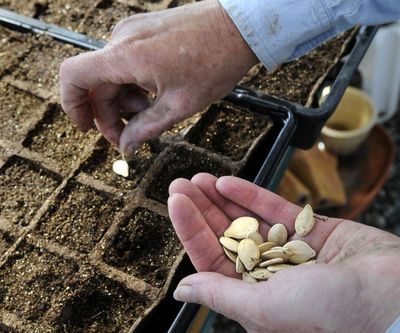Gardening: Too early to start seeds, but never too early to organize

It was almost light when I drove home from work late last week. The world is waking up again from its winter sleep. Bit by bit over the next few weeks, the light will return, and we can begin to look toward spring and planting our vegetable and flower starts.
It’s a bit early to start anything right now but it is a good time to gather your equipment and get your space set up.
You can start seeds in any space that can be kept at an even temperature of 60 to 70 degrees. This can be a basement room, the spare bedroom or a corner of the family room away from furnace vents and cold windows.
Windowsills are probably not the best place for seed starting because our nights will be too cold well into March. Freshly planted seeds germinate faster with a little bottom heat provided by a greenhouse heat mat set under your trays.
They are available at some garden centers and online and come in several sizes.
Seedlings and small vegetable starts will need 14 to 16 hours of light to grow into strong plants. The lights can be something as simple as the relatively inexpensive 4-foot shop light fixtures with florescent or LED tubes on up to the more expensive full spectrum grow lights set up on a timer. The lights will need to be positioned within 2 inches of the plants and will need to be raised as the plants get taller. This will necessitate building or buying a stand that can support the lights over the plants.
To maximize the space under your lights, use square or rectangle plastic flats to hold your planting pots. Most gardeners I know have a stash of old flats left over from nursery shopping. Try to use ones with solid bottoms so water doesn’t get everywhere when you are watering. There are some nifty self-watering growing flats available online that can supply water to the plants through a capillary mat under the pots. All you need to do is regularly fill the water reservoir.
Planting containers come in many shapes and sizes from multicelled lightweight plastic containers called pony packs to compressed peat or coir fiber pellets to homemade pots rolled from newspaper. Use whatever you have access to as long as they efficiently fill your flats. Sometimes I will use a 4-inch pot from the start to save having to transplant into a larger pot later in the spring.
Lastly use a good quality soilless germinating mix to plant into. This mix is made with finely milling peat moss or coir fiber and compost with perlite added for drainage. The fine texture allows the seeds to poke through the surface easily and is less likely to crust over when it dries out. Moisten the mix a couple of days before you plant by adding water and allowing it to soak in. The mix should be as moist as a wrung-out sponge when you start planting.
Master Gardener Pat Munts is co-author, with Susan Mulvihill, of the “Northwest Gardener’s Handbook.” Munts can be reached at pat@ inlandnwgardening.com.